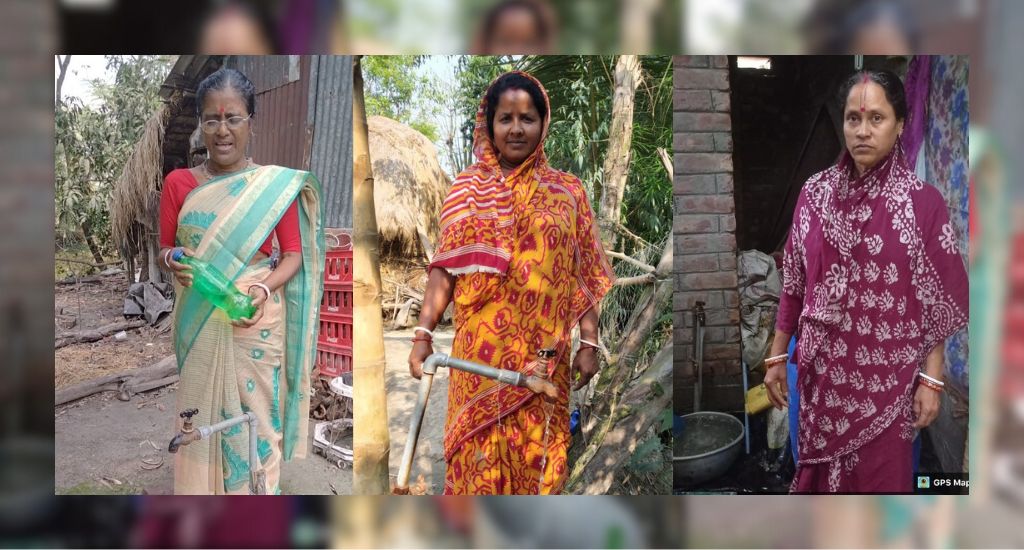
Drinking water no longer a distant luxury for remote Bengal
The climate-impacted communities in West Bengal no longer have to walk long distances to fetch water since the Jal Jeevan Mission has enhanced access, significantly improving their lives.

The climate-impacted communities in West Bengal no longer have to walk long distances to fetch water since the Jal Jeevan Mission has enhanced access, significantly improving their lives.
The objective of the Jal Jeevan Mission (JJM), a scheme rolled out by Prime Minister Narendra Modi on 15 August, 2019, is to provide piped water supply to every rural household by 2024. The mission aims to provide 55 litres of drinking water per person per day through functional household tap connections. It is a people-centric and cost-effective approach to provide drinking water to rural households.
The following success stories in Gosaba and Sagar – the most climate-impacted administrative blocks of West Bengal – showcase how lives and livelihood of communities in rural West Bengal have seen a transformation.
Sagar Island, comprising 42 villages, lies in the Ganges delta of the Bay of Bengal. The island experiences a tropical climate, and people here have been fighting against climate issues such as rising sea levels (estimated sea level rise is 3.1 mm per year), increased soil salinity, tidal surges, violent cyclones and severe coastal erosion.

A study by Aparna Bera of Jaipur-based Suresh Gyan Vihar University and a team from multiple institutions (published on 6 March 2022) showed that 19.5 percent of mouzas (administrative units of the island), housing 15.33 percent of the population, are at high risk of facing climate change impacts. These people inhabit the Sibpur–Dhablat, Bankimnagar–Sumatinagar and Beguakhali–Mahismari areas in the southern part of the island. They also face a huge economic impact.
The island is located about 56.70 nautical miles from Kolkata and covers about 282.11 sq km area. As per the 2011 Census, the population of this climate-impacted land is 2,12,037.
During a field visit, the Jal Jeevan Mission project team found out about prevailing water scarcity in Kaylapara village, located in the Das Para Sumatinagar-I panchayat of Sagar administrative block. The officials followed the JJM guidelines and took the necessary steps to provide access to clean water to the villagers through tap connections. As per the West Bengal Public Health Engineering Department dashboard, the project team has provided access to clean water to 95.45 percent of villagers.
Also Read | Old well lone lifeblood for water-parched Bengal village
It has changed the villagers’ quality of life significantly. The children attend school regularly since they don’t have to fetch drinking water from far away. Families have stopped buying drinking water and it has helped them to save money considerably. Workshops, information dissemination, education and communication campaigns have promoted sustainable usage of water among the villagers.
Mitrapur, which lies in the Sundarbans in 24 Parganas district, is known for its difficult terrain and frequent natural disasters such as cyclones and floods. Villagers earlier had to cover several miles every day to get clean drinking water.

In 2022, the villagers of Mitrapur were provided tap water connections in their homes through JJM.
The implementation was not without its challenges, as the rugged topography and lack of infrastructure made it challenging to lay pipelines and set up the water supply system. However, with the support of the local administration and community leaders, the project was implemented.
Today the villagers of Mitrapur have access to safe and clean drinking water through taps, a luxury that was once unimaginable for them. It has helped the local people save time and effort in collecting drinking water. The project has also reduced gender gaps.
The success of the JJM programme in Mitrapur has not only improved the quality of life for the villagers but has also inspired neighbouring villages to demand tap water connections. However, a lot of work still remains to be done to achieve the project goal.
The local administration has now taken up the task of providing tap water connections to other remote villages in the Sundarbans region too.
Also Read | Dry taps drive people to toxic groundwater in Bihar
The lead image at the top shows in addition to getting tap water, villagers have learnt about sustainable water usage (Photo by Sonia Mondal and Mukul Midday of the project implementation partner NGO, Haldah Eastern Society)
Rangeet Mitra is a development professional who works with several central and state government departments as well as non-governmental organisations. He is a chemical engineer with an MBA in public systems (environment).